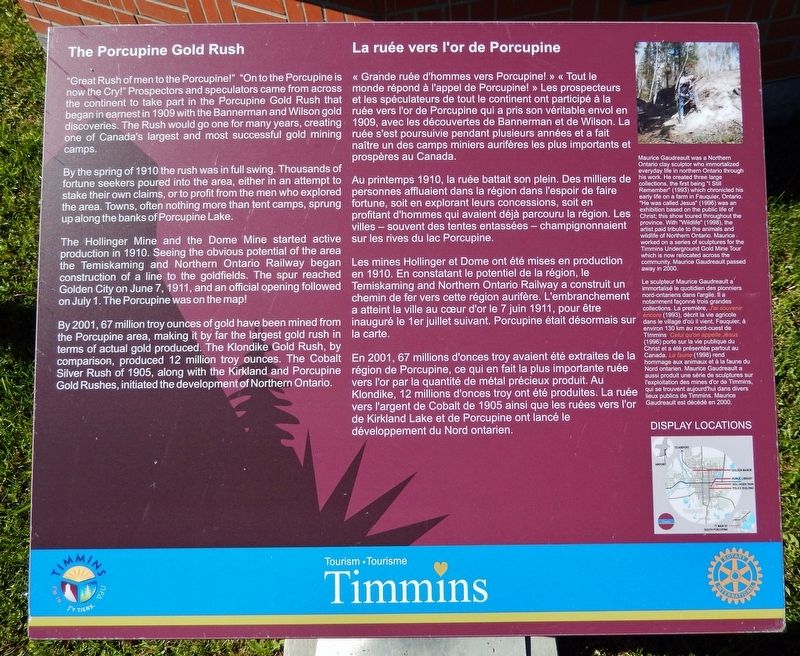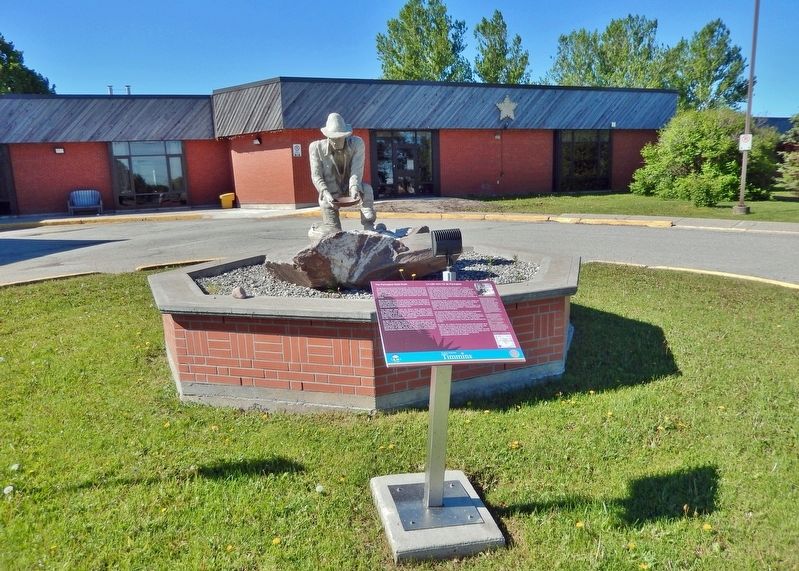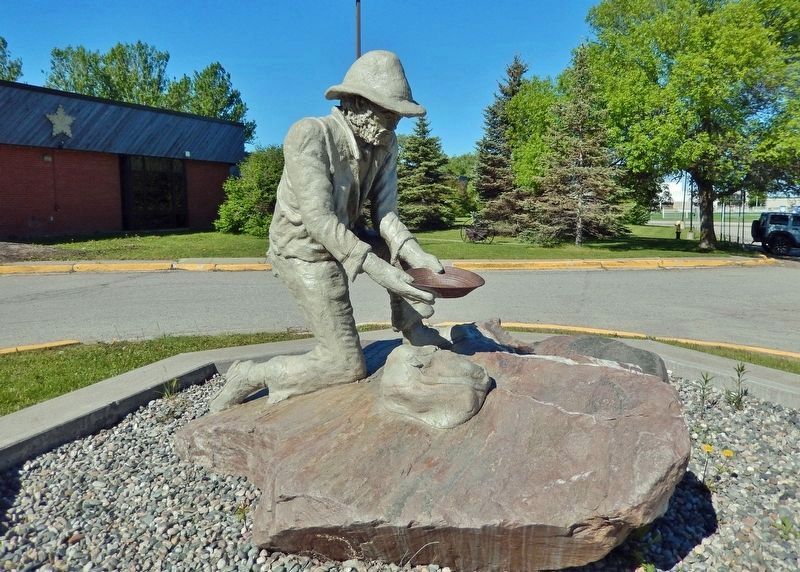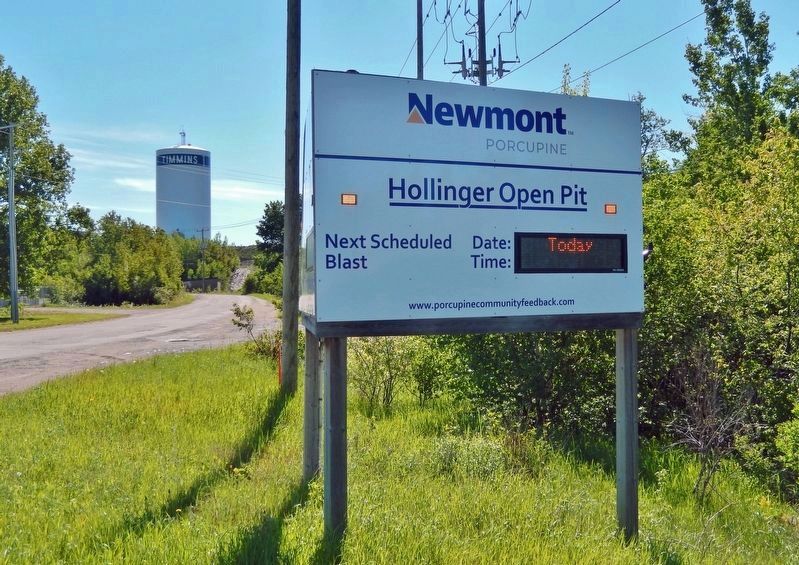Timmins in Cochrane District, Ontario — Central Canada (North America)
The Porcupine Gold Rush / La Ruée vers l'or de Porcupine
Inscription.
By the spring of 1910 the rush was in full swing. Thousands of fortune seekers poured into the area, either in an attempt to stake their own claims, or to profit from the men who explored the area. Towns, often nothing more than tent camps, sprung up along the banks of Porcupine Lake.
The Hollinger Mine and the Dome Mine started active production in 1910. Seeing the obvious potential of the area the Temiskaming and Northern Ontario Railway began construction of a line to the goldfields. The spur reached Golden City on June 7, 1911, and an official opening followed on July 1. The Porcupine was on the map!
By 2001, 67 million troy ounces of gold have been mined from the Porcupine area, making it by far the largest gold rush in terms of actual gold produced. The Klondike Gold Rush, by comparison, produced 12 million troy ounces. The Cobalt Silver Rush of 1905, along with the Kirkland and Porcupine Gold Rushes, initiated the development of Northern Ontario.
Maurice Gaudreault was a Northern Ontario clay sculptor who immortalized everyday life in northern Ontario through his work. He created three large collections, the first being "I Still Remember" (1993) which chronicled his early life on a farm in Fauquier, Ontario. "He was called Jesus" (1996) was an exhibition based on the public life of Christ; this show toured throughout the province. With "Wildlife" (1998), the artist paid tribute to the animals and wildlife of Northern Ontario. Maurice worked on a series of sculptures for the Timmins Underground Gold Mine Tour which is now relocated across the community. Maurice Gaudreault passed away in 2000.
Au printemps 1910, la ruée
battait son plein. Des milliers de personnes affluaient dans la région dans l'espoir de faire fortune, soit en explorant leurs concessions, soit en profitant d'hommes qui avaient déjà parcouru la région. Les villes — souvent des tentes entassées — champignonnaient sur les rives du lac Porcupine.
Les mines Hollinger et Dome ont été mises en production en 1910. En constatant le potentiel de la région, le Temiskaming and Northern Ontario Railway a construit un chemin de fer vers cette région aurifère. L'embranchement a atteint la ville au cœur d'or le 7 juin 1911, pour être inauguré le 1 er juillet suivant. Porcupine était désormais sur la carte.
En 2001, 67 millions d'onces troy avaient été extraites de la région de Porcupine, ce qui en fait la plus importante ruée vers l'or par la quantité de métal précieux produit. Au Klondike, 12 millions d'onces troy ont été produites. La ruée vers l'argent de Cobalt de 1905 ainsi que les ruées vers l'or de Kirkland Lake et de Porcupine ont lancé le développement du Nord ontarien.
Le sculpteur Maurice Gaudreault a immortalisé le quotidien des pionniers nord-ontariens dans l'argile. Il a notamment façonné trois grandes collections. La première, J’ai souvenir encore, (1993), décrit la vie agricole dans le village d'où il vient, Fauquier, à environ 130 km au nord-ouest de Timmins. Celui qu'on appelle Jésus
(1996) porte sur la vie publique du Christ et a été présentée partout au Canada. La Faune (1998) rend hommage aux animaux et à la faune du Nord ontarien. Maurice Gaudreault a aussi produit une série de sculptures sur l'exploitation des mines d'or de Timmins, qui se trouvent aujourd'hui dans divers lieux publics de Timmins. Maurice Gaudreault est décédé en 2000.
Erected by Timmins Tourism and Rotary Club International.
Topics and series. This historical marker is listed in these topic lists: Arts, Letters, Music • Industry & Commerce • Railroads & Streetcars • Settlements & Settlers. In addition, it is included in the Rotary International series list. A significant historical year for this entry is 1909.
Location. 48° 29.145′ N, 81° 20.666′ W. Marker is in Timmins, Ontario, in Cochrane District. Marker is on University Street, 0.1 kilometers south of Jubilee Avenue West, in the median. The marker and sculpture are located in the center island of the Golden Manor entrance circular driveway. Touch for map. Marker is at or near this postal address: 481 Melrose Boulevard, Timmins ON P4N 5H3, Canada. Touch for directions.
Other nearby markers. At least 8 other markers are within 11 kilometers of this marker, measured as the crow flies. CFCL Radio / Station de radio CFCL (approx. 1.2 kilometers away); Shania Twain (approx. 1.7 kilometers away); Gold Mining in Canada / Production de l'or au Canada
(approx. 2 kilometers away); "The Big Three" / Les trois principales mines (approx. 2 kilometers away); Ore From the Kidd Creek Mine (approx. 3.5 kilometers away); The Refinery Pour / La coulée de l'or (approx. 9.2 kilometers away); The Gold Seekers / Les chercheurs d'or (approx. 9.9 kilometers away); Tisdale Township Municipal Building (approx. 9.9 kilometers away). Touch for a list and map of all markers in Timmins.
Related markers. Click here for a list of markers that are related to this marker. Timmins Heritage Tour
Also see . . .
1. Porcupine Gold Rush. Excerpt:
The Porcupine Gold Rush took place in Northern Ontario starting in 1909 and developing fully by 1911. The mines peaked between the 1940s and the 1950s but still continue to produce gold although the many smaller mines have been consolidated into a small number of larger holdings. By 2001, 67 million troy ounces of gold have been mined from the Porcupine area, making it by far the largest gold rush in terms of actual gold produced. For comparison, the well-known Klondike Gold Rush produced about 12 million troy ounces. The Porcupine rush, along with the Cobalt Silver Rush and Kirkland Lake Gold Rush, all in the early 20th century, drove most of the settlement effort in northern Ontario.(Submitted on April 5, 2024, by Cosmos Mariner of Cape Canaveral, Florida.)
2. Hollinger Mines (Wikipedia). Excerpt:
The Hollinger Gold Mine was discovered on October 9, 1909, by Benny Hollinger, who found the gold-bearing quartz dike that later became known as Hollinger Mines. With his friend, professional prospector Alex Gillies, Hollinger had travelled to the Porcupine region in the wake of the Wilson expedition, which had recently discovered the future Dome Mine site. Hollinger sold his claim to a small syndicate led by Noah Timmins that, in 1910, incorporated as Hollinger Mines in Timmins, Ontario. The main Hollinger gold mine operated from 1910 until 1968. The value of the gold produced is placed at $564.7 million. Hollinger Consolidated Gold Mines was later acquired by Canadian tycoon E. P. Taylor's Argus Corporation. Argus was taken over by Conrad Black in 1978, and it was subsequently known as Hollinger Inc.(Submitted on April 5, 2024, by Cosmos Mariner of Cape Canaveral, Florida.)
3. Hollinger Open Pit - Porcupine. Excerpt:
Located in and around the City of Timmins, the Porcupine district has produced more than 67 million ounces since 1910. Currently, approximately 60% of the gold comes from the Hoyle Pond underground mine, where mechanized cut and fill and longhole mining methods are used to extract the ore, and the remaining ore comes from the Hollinger Open Pit mine. The Dome Underground mine ceased operations in 2017.(Submitted on April 5, 2024, by Cosmos Mariner of Cape Canaveral, Florida.)
4. Maurice Gaudreault (1932–2000). Excerpt:
(English translation) At 14, like many young people of his generation, Maurice left school to go to the construction site and pursue a thousand and one trades. In the early 1980s, Maurice Gaudreault became an artist in residence at the Kapuskasing Recreation Center. This artist immortalized the history of the pioneers of Northern Ontario using the medium he loved and knew best: clay. (Paul-François Sylvestre)(Submitted on April 6, 2024, by Cosmos Mariner of Cape Canaveral, Florida.)“Maurice often told me that he wrote the history of Northern Ontario in his own way and that he wanted young people to remember the past.” As I recount in the book I wrote in 2002 entitled Maurice Gaudreault, a sculptor of stories, Maurice was, in my opinion, a pioneer in the art of telling the story of our ancestors. He did not resort to words or literature. He used the material he particularly liked: earth! (Stéphane Laberge)
Credits. This page was last revised on April 6, 2024. It was originally submitted on April 5, 2024, by Cosmos Mariner of Cape Canaveral, Florida. This page has been viewed 43 times since then. Photos: 1, 2, 3, 4. submitted on April 5, 2024, by Cosmos Mariner of Cape Canaveral, Florida.



